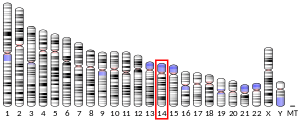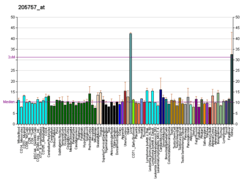ENTPD5
Ectonucleoside triphosphate diphosphohydrolase 5 is an enzyme that in humans is encoded by the ENTPD5 gene.[5][6][7]
ENTPD5 is similar to E-type nucleotidases (NTPases)/ecto-ATPase/apyrases. NTPases, such as CD39, mediate catabolism of extracellular nucleotides. ENTPD5 contains 4 apyrase-conserved regions which is characteristic of NTPases.[7]
References
- GRCh38: Ensembl release 89: ENSG00000187097 - Ensembl, May 2017
- GRCm38: Ensembl release 89: ENSMUSG00000021236 - Ensembl, May 2017
- "Human PubMed Reference:". National Center for Biotechnology Information, U.S. National Library of Medicine.
- "Mouse PubMed Reference:". National Center for Biotechnology Information, U.S. National Library of Medicine.
- Chadwick BP, Frischauf AM (Oct 1997). "Cloning and mapping of a human and mouse gene with homology to ecto-ATPase genes". Mamm Genome. 8 (9): 668–72. doi:10.1007/s003359900534. PMID 9271669.
- Chadwick BP, Frischauf AM (Oct 1998). "The CD39-like gene family: identification of three new human members (CD39L2, CD39L3, and CD39L4), their murine homologues, and a member of the gene family from Drosophila melanogaster". Genomics. 50 (3): 357–67. doi:10.1006/geno.1998.5317. PMID 9676430.
- "Entrez Gene: ENTPD5 ectonucleoside triphosphate diphosphohydrolase 5".
Further reading
- Mulero JJ, Yeung G, Nelken ST, Ford JE (1999). "CD39-L4 is a secreted human apyrase, specific for the hydrolysis of nucleoside diphosphates". J. Biol. Chem. 274 (29): 20064–7. doi:10.1074/jbc.274.29.20064. PMID 10400613.
- Recio JA, Zambrano N, Peña L, et al. (2000). "The human PCPH proto-oncogene: cDNA identification, primary structure, chromosomal mapping, and expression in normal and tumor cells". Mol. Carcinog. 27 (3): 229–36. doi:10.1002/(SICI)1098-2744(200003)27:3<229::AID-MC10>3.0.CO;2-Z. PMID 10708485.
- Mulero JJ, Yeung G, Nelken ST, et al. (2000). "Biochemical characterization of CD39L4". Biochemistry. 39 (42): 12924–8. doi:10.1021/bi000960y. PMID 11041857.
- Strausberg RL, Feingold EA, Grouse LH, et al. (2003). "Generation and initial analysis of more than 15,000 full-length human and mouse cDNA sequences". Proc. Natl. Acad. Sci. U.S.A. 99 (26): 16899–903. doi:10.1073/pnas.242603899. PMC 139241. PMID 12477932.
- Blánquez MJ, Regadera J, Mariño J, et al. (2003). "Gradual deregulation and loss of PCPH expression in the progression of human laryngeal neoplasia". Mol. Carcinog. 35 (4): 186–95. doi:10.1002/mc.10091. PMID 12489110.
- Murphy-Piedmonte DM, Crawford PA, Kirley TL (2005). "Bacterial expression, folding, purification and characterization of soluble NTPDase5 (CD39L4) ecto-nucleotidase". Biochim. Biophys. Acta. 1747 (2): 251–9. doi:10.1016/j.bbapap.2004.11.017. PMID 15698960.
- Liu T, Qian WJ, Gritsenko MA, et al. (2006). "Human Plasma N-Glycoproteome Analysis by Immunoaffinity Subtraction, Hydrazide Chemistry, and Mass Spectrometry". J. Proteome Res. 4 (6): 2070–80. doi:10.1021/pr0502065. PMC 1850943. PMID 16335952.
- Regadera J, Blánquez MJ, González-Peramato P, et al. (2006). "PCPH expression is an early event in the development of testicular germ cell tumors". Int. J. Oncol. 28 (3): 595–604. doi:10.3892/ijo.28.3.595. PMID 16465363.
- Villar J, Arenas MI, MacCarthy CM, et al. (2007). "PCPH/ENTPD5 expression enhances the invasiveness of human prostate cancer cells by a protein kinase C delta-dependent mechanism". Cancer Res. 67 (22): 10859–68. doi:10.1158/0008-5472.CAN-07-2041. PMID 18006831.
This article is issued from Wikipedia. The text is licensed under Creative Commons - Attribution - Sharealike. Additional terms may apply for the media files.




